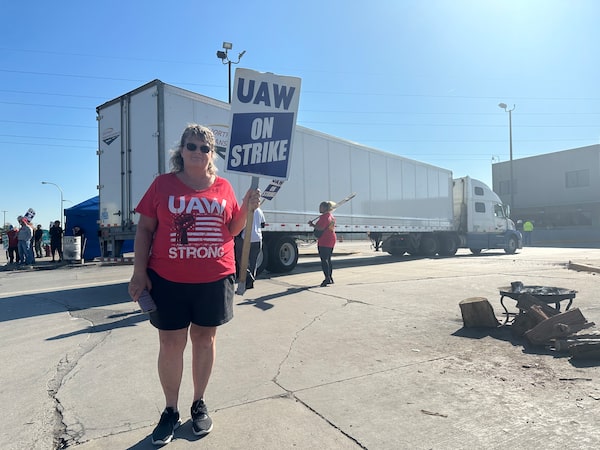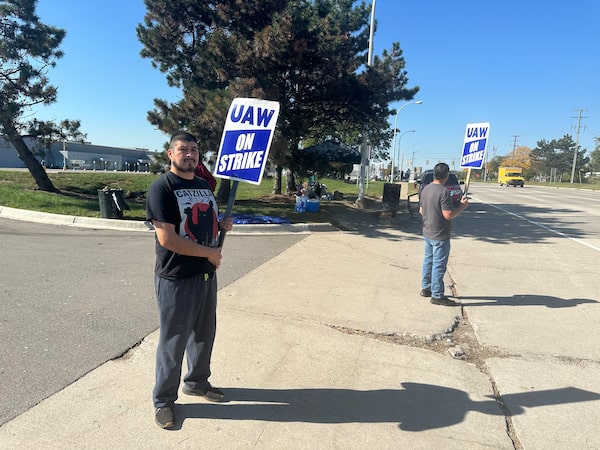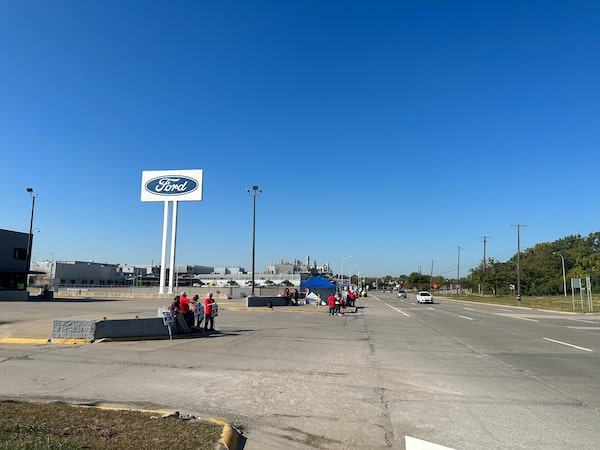
Julie Geierman on the picket line at a Ford plant in Wayne, Mich., on Oct. 4.Adrian Morrow/The Globe and Mail
When the United Auto Workers agreed to major contract concessions in 2009, Christy Barrymore was in full support. Working at a Ford Motor Company parts plant in Saline, Mich., at the time, she saw the sacrifices as necessary to save an iconic U.S. industry from collapse in the Great Recession. She doesn’t remember a single co-worker complaining.
“We were all very proud. We didn’t mind doing that because we understood that there was a business to run,” Ms. Barrymore, 54, recalled. “We thought we’d get everything back once they were super-profitable again.”
But the Big Three U.S. automakers – Ford F-N, General Motors Co. GM-N and Stellantis NV STLA-N – have kept the concessions in place for almost a decade and a half. Among other things, workers have been without a cost-of-living adjustment, allowing inflation to outstrip their wages. Those hired after 2007 are in a different pay tier, with a lower wage grid, than their veteran counterparts. And the companies have further outsourced parts manufacturing, selling off factories such as the one in Saline, which made plastic components for vehicle interiors.
Meanwhile, the Big Three have raked in a combined US$250-billion in profits over the past decade, completed stock buybacks and jacked up chief executive pay to tens of millions a year.
“They’ve been profitable forever, and we still haven’t gotten back what we gave up,” Ms. Barrymore said on the picket line outside Ford’s truck assembly plant in the Detroit suburb of Wayne, where she went to work after the Saline plant was sold.

Striking UAW members Mario Williams and Christy Barrymore. Ms. Barrymore works at an assembly plant in the Detroit suburb of Wayne, where she went after the Saline plant was sold.Adrian Morrow/The Globe and Mail
This incongruity is at the centre of the current strike roiling the automakers, the UAW’s most aggressive attempt in decades to secure better wages and working conditions. The union is demanding a 40-per-cent raise over four years and eight months and an end to tiered pay scales.
The job action is part of a rise in labour activism across the U.S., with everyone from airline pilots to UPS drivers winning big raises this year, Hollywood writers and actors walking off the job, and workers at Starbucks and Amazon fighting to unionize.
“Workers are tired of CEOs and the top 1 per cent getting all this money. There’s supposed to be a trickle-down effect, which is a joke. None of it ever gets to the bottom,” said Isai Morales, 34, as he too walked the picket line in Wayne, which stretched for almost two kilometres along the side of a suburban arterial road.
Mr. Morales makes US$16.67 an hour installing bumpers on the factory’s chassis line. It’s not enough for someone aspiring to a middle-class life. “I just want to buy a house and buy a car and pay my bills and go on vacation,” he said. “I want the American dream.”

Isai Morales says his current wage is not enough for someone aspiring to a middle-class life. 'I just want to buy a house and buy a car and pay my bills and go on vacation,' he says.Adrian Morrow/The Globe and Mail
Hailey Mayes, 24, said she sometimes has to work 60-hour weeks to make ends meet, often missing out on family time as a result. Gazing out at the sprawling, empty parking lot in front of the plant, where she has worked for four years, she’s optimistic the strike will achieve its aims.
“They’re going to have to give. We just have to get them to the breaking point. As long as it takes,” she said.
The impetus behind the strike is Shawn Fain, the UAW’s fiery new president. The 54-year-old Indiana electrician is fond of quoting Malcolm X and explicitly framing the labour dispute in political terms. His opening negotiating position was to demand for workers the same 46-per-cent pay increase that auto CEOs have received over the past 15 years.
Unlike previous contract talks, in which the UAW negotiated with one company at a time, Mr. Fain has launched the union’s first-ever simultaneous strike against all three. Since the strike began three weeks ago, he has gradually turned up the pressure, expanding the number of plants hit by walkouts from three to 43.
He has reason to believe the moment is right to push for more. The UPS agreement this past summer abolished a two-tier wage system in addition to hiking pay across the board. At the country’s three largest airlines, pilots negotiated raises of 34 per cent to 46 per cent this year.
“This is a reflection of multiple decades of working people not keeping pace with inflation and watching inequality grow,” said Lana Payne, the president of Unifor, the union that represents autoworkers in Canada.
She and Mr. Fain have been in regular contact over the past month as she also negotiates with the Big Three’s Canadian units. Unifor, which is sticking to the traditional bargaining approach of working on each contract sequentially, concluded a collective agreement last month with Ford that includes double-digit pay raises and cuts in half the length of time it takes to move up from the bottom wage tier. It also provides pay assistance to workers who are temporarily laid off while plants retool to build electric vehicles.
In a sign of how much the U.S.’s political culture has shifted, the most vocal support in the strike has been for the UAW. Last week, Joe Biden became the first sitting U.S. president to join a picket line when he stumped with Mr. Fain outside a GM parts centre near Detroit. The stakes for Mr. Biden are high in this key swing state, where he is eager to show it’s possible to transition to electric vehicles without sacrificing union wages.
“Seeing him on a picket line is a powerful signal that we have a different understanding of what workers are entitled to and how they can get it,” said Jim Stanford, the director of the Centre for Future Work, a left-wing Canadian-Australian think tank.

The Ford truck assembly plant in Wayne, Mich.Adrian Morrow/The Globe and Mail
Still, he cautioned, the surge in activism has not yet turned around the U.S.’s long-term decline in unionized workers. Efforts to negotiate collective agreements at newly unionized workplaces such as Starbucks have also often stalled. “The mere fact that people support what you’re doing doesn’t necessarily mean you’re going to win,” he said.
Julie Geierman, who works in the Wayne factory’s paint shop, expresses a common concern about the electric-vehicle transition: that the Big Three will primarily contract with non-union battery plants in a bid to keep labour costs in line with those at stridently anti-union Tesla. “We’re not going to stand for the battery plants making less money,” she said.
Such a move would effectively replicate the wage tiers the UAW is fighting to eliminate. It’s a disparity Ms. Geierman, 56, knows well. Hired 12 years ago, she spent the first eight on a bottom tier. “We would work across the line from people making six, seven, eight dollars more than us for doing the same work,” she said. “It was disheartening.”
Mario Williams is also fine with an EV transition, as long as the vehicles are made by union labour. Current and future autoworkers, he said, should enjoy the same benefits he did.
“We know the future is switching over for the environment. But we still have to make a living,” said the 56-year-old, who has done everything from installing heat shields to performing quality control since joining Ford in 1994. “We put a lot of blood, sweat and tears into making these cars and we need to be compensated for it. Now is the time.”
 Adrian Morrow
Adrian Morrow